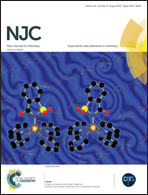3(2H)-Furanone as a promising scaffold for the synthesis of novel fluorescent organic dyes: an experimental and theoretical investigation†
Abstract
3(2H)-Furanones are a type of five-membered heterocyclic compounds of synthetic and biological importance. For exploring the utilities of this “sweet” aroma component for bio-analytical purposes we have prepared and characterized two novel fluorophores (2Z)-2-(5-fluoro-2-ntro benzylidene)-5-phenyl-3(2H)-furanone (FNPF) and (2Z)-2-(4-carboxy benzylidene)-5-phenyl-3-(2H)-furanone (CBPF) on a 3-furanone skeleton. In order to expand their application potential, the photophysical properties have been investigated using absorption and emission spectroscopy, in combination with quantum chemical calculations. As expected, both compounds showed efficient solvatochromic properties and the excited state dipole moments are larger than those of the ground state. Solvent dependent spectral data using TD-DFT calculations on the optimized ground and excited state structures of both compounds were found to correlate well with the experimental findings.


 Please wait while we load your content...
Please wait while we load your content...